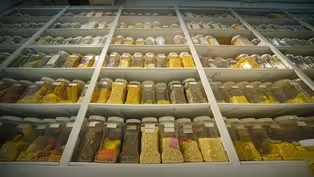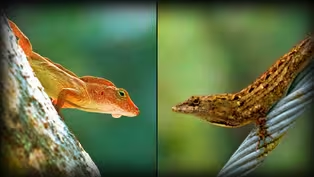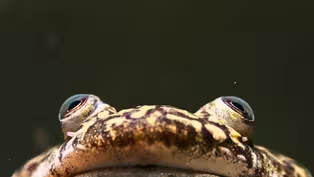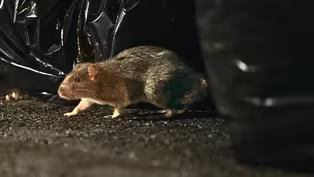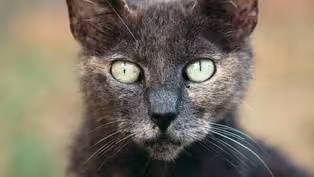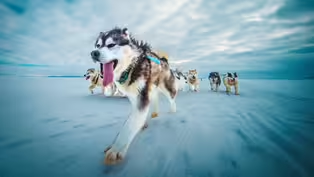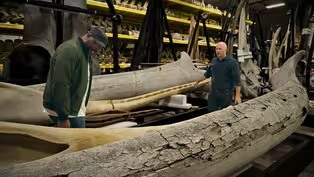
How Giant Pythons Became Florida’s Biggest Invasive Species
Special | 13m 24sVideo has Closed Captions
Ever heard of the phrase "when pet pythons outgrow their owners"?
Ever heard of the phrase "when pet pythons outgrow their owners"? Well, host Shane Campbell-Staton is about to take us on an adventure to find out what happens next. Join Shane as he meets bounty hunter Donna Kalil, exotic animal trader Hillary Dupont, and biologists Matthew McCollister and Kristen Hart as they battle the invasive Burmese Pythons of the Everglades.
Problems playing video? | Closed Captioning Feedback
Problems playing video? | Closed Captioning Feedback

How Giant Pythons Became Florida’s Biggest Invasive Species
Special | 13m 24sVideo has Closed Captions
Ever heard of the phrase "when pet pythons outgrow their owners"? Well, host Shane Campbell-Staton is about to take us on an adventure to find out what happens next. Join Shane as he meets bounty hunter Donna Kalil, exotic animal trader Hillary Dupont, and biologists Matthew McCollister and Kristen Hart as they battle the invasive Burmese Pythons of the Everglades.
Problems playing video? | Closed Captioning Feedback
How to Watch Human Footprint
Human Footprint is available to stream on pbs.org and the free PBS App, available on iPhone, Apple TV, Android TV, Android smartphones, Amazon Fire TV, Amazon Fire Tablet, Roku, Samsung Smart TV, and Vizio.
Buy Now

Surprising Moments from Human Footprint
Do you think you know what it means to be human? In Human Footprint, Biologist Shane Campbell-Staton asks us all to think again. As he discovers, the story of our impact on the world around us is more complicated — and much more surprising — than you might realize.Providing Support for PBS.org
Learn Moreabout PBS online sponsorshipMore from This Collection
Human Footprint is a show that delves into the impact of humans on the planet. Join Shane as he travels from farms to restaurants, from high-tech labs to street markets, and from forests to cities to uncover the consequences of our unique history. Are you ready to explore our past, present, and future as a species?
Video has Closed Captions
Watch the rise of a productive crop that has managed to replace itself, but at what cost? (11m 24s)
The Watery Price Of Golf Courses & Lawns
Video has Closed Captions
The cultural and resource costs for manicured lawns and golf courses are quite shocking. (11m 29s)
How Dogs Are Shaping The Future Of Medicine
Video has Closed Captions
Observe the rich diversity of dog breeds, shaped by genes and human intervention. (12m 43s)
We Brought This Fish To America. Now We Can't Get Rid Of It
Video has Closed Captions
Expose Asian carp for disrupting native fish species and shrinking their populations. (10m 39s)
Why Are These Urban Lizards Evolving in Overdrive?
Video has Closed Captions
Examine city-dwelling anoles with remarkable evolutionary changes. (10m 33s)
How An Ancient Ocean Shaped Us History
Video has Closed Captions
Learn how millions of years of deposits shaped the events of Black American history. (16m 54s)
Video has Closed Captions
What happens when frogs become indispensable? (8m 59s)
Video has Closed Captions
When it comes to NYC, the rat is the undisputed king! (13m 26s)
Your Cat’s Secret Life (as a Deadly Predator)
Video has Closed Captions
Cats have been winning the hearts of humans for years....but can devastate ecosystems. (10m 40s)
Singapore: Designing a Megacity in Harmony with Nature
Video has Closed Captions
Green spaces aren't just an afterthought here - they're mandatory! (13m 24s)
Sled Dogs: The Most Extreme Distance Athletes on Earth
Video has Closed Captions
In the Arctic, it's not just about muscle power, but brainpower too. (15m 17s)
Secrets of the World’s Only Whale Warehouse
Video has Closed Captions
Uncover the history of whaling and its impact on our oceans. (9m 58s)
Providing Support for PBS.org
Learn Moreabout PBS online sponsorshipAnother monster gone!
Oh my gosh.
Burmese Pythons have transformed the entire ecosystem of South Florida.
After arriving here as seemingly innocent pets, these snakes have overrun their new environment in just a few decades.
The thing is, there’s still a lot we don’t know about how these elusive snakes live in the wild, like how long they live, how far they move, or even how many offspring they have.
And the only way to find out... well, is to catch them.
So I met up with a python hunter, an exotic pet dealer, and a team of wildlife biologists to get the story behind the invasion, and see how these dedicated south Floridians are working together to protect these natural habitats.
I'm Shane Campbell-Staton, and this is Human footprint.
Once I see it, adrenaline starts pumping and, you know, the game's on.
I've caught on full moons, I've caught below 75.
I've caught on windy days.
So, you know, you just got to be out here.
You never know when a python's going to be out here moving around.
In 2017, Donna Kalil quit her job in real estate to become a full-time Burmese python hunter.
I'm loving the, loving this uh, the snake leather.
It's nice and supple.
Right there.
Yeah!
Love the trim.
It helps my volunteers, you know, remember what you're looking for out there.
What made you decide to take up the mantle of python wrangler?
I know how to catch snakes.
I've known how to all my life.
And I knew that I can make a difference to the environment that I love.
What is the largest python you’ve caught?
The largest I've caught was 16 even.
Oh wow!
These guys didn't sprout wings and fly over from Southeast Asia.
We brought them here.
So we made the problem.
We got to, we got to fix it.
One way Florida is trying to fix the problem is by paying folks like Donna to capture and kill the pythons.
So far, she’s brought in more than 600 of them.
So if you do see something on the road, yell “Python,” and then we're good to go.
Awesome.
Let's ride.
I so highly respect these things because they're in an environment that they were put in, and they took over.
Oh, will you stop?
Back up just a little bit.
Got something?
Stop.
Let me go check.
It was down by the trees?
Both of us saw it.
When they feel vibrations coming at them, when they think that there's something's coming at them, they're going to take off.
There is a gator right there.
You definitely saw a python though?
I’m positive.
If it was a python, it got to the water before we got to it.
To understand how the python problem started, you need to understand the Florida pet trade.
Some of the snakes Donna and I were looking for came from stores a lot like this one in Palm Beach County.
We had a 22 foot reticulated python named Heather.
We named her after my sister.
I never really had a fear of big snakes.
Hillary Dupont took over the store from her parents, who started it in the 90s.
Her dad was a herpetologist and zookeeper, so Hillary’s been around exotic animals her whole life.
So I grew up, back in the day, I have pictures, where my Dad used to bring home the lions and the chimpanzees from lion country, back when that was “OK”!
Hillary’s bringing up her children in this world too, and from what I can see, they’re into it.
I mean, really, what kid wouldn’t love growing up with all these animals in the family?
Did a lot of Burmese pythons come through this store?
Were they sold here?
Yeah, we did.
We had a lot of Burmese pythons come in and out and people would buy them.
And then, of course, when they got to a certain size, they were like, oh, where are we going to keep this?
Where are we going to put this?
And they would bring them back.
But not everyone took their pythons back to the store.
Many dumped them into the closest wetland.
Yes, we're 100% at fault for contributing to that back in the day, but that's where I'm redeeming myself.
Florida Fish and Wildlife called us and said, do you want to be a drop center?
And we said, absolutely.
And so that's when they started getting dropped to us.
Wildlife drop centers provide a safe place for people to bring unwanted pets… so Hillary’s store is a rare place where you can see Burmese pythons kept legally in Florida.
Can I see one of these guys?
You wanna go see one of them?
Oh, yeah.
I'll bring you over there.
Come on, darling.
Oh, my goodness.
Come on.
Boy’s got body, as they say.
This is Satan.
This is Satan?
I know.
It's a horrible name.
He's kind of heavy and lanky.
Alright Satan, let's say hello to everybody.
How long is Satan?
Well, he's around eight feet.
Okay.
And how old is the Prince of Darkness?
We've had him for around five or six years.
In a glass cage, these snakes seem harmless.
But when they were released into a new environment, the results were devastating.
Scientists are still trying to understand just how large of an impact they’re having.
What they do know is that with their indiscriminate appetite, these snakes are wreaking havoc on the ecosystem’s native species.
Burmese Pythons can take out the ecosystem’s apex predators, like alligators and crocodiles, upsetting the delicate balance in the Everglades which is home to endangered species like the Florida panther.
And they can pose a risk to humans too.
While Burmese Pythons typically stay far away from us, they can strike with and constrict to defend themselves and are fully capable of devouring cats and dogs.
The animal is a challenge like no other.
There’s a lot of surprises.
This is ecologist Kristen Hart of the US Geological Survey.
When she’s not chasing personal bests, she’s chasing down pythons… Kristen and Matt McCollister of the National Park Service are part of a team that’s trying to learn everything they can about how these snakes live in the Florida swamps.
Today on the to-do list is to check two of our transmitted females.
Okay.
She was around 125 pounds when she was caught about this time last year.
This is a basic radio tag.
Okay.
This is for an adult.
We anchor it to the rib.
So, there's a surgery to put the tags in.
We put two in, so we don't lose them.
They have a different frequency.
So should one die, one tag, the battery expire, we still have a backup.
And so it goes actually in the body in a surgery.
And then we feed the antenna also right under the skin.
You can hear it in the animal.
It's all inside.
So they come in for surgery based on the expected battery life.
It seems pretty straightforward, but at the same time, it's a very technologically advanced solution.
It's a really important tool for us.
If we’re just walking around the woods, you're not likely to find a python.
The tags are definitely the thing that help us track these animals.
The team has radio tagged over 60 pythons.
But they’re still learning the most basic facts about this species’ biology… like how long they live, how far they move, and how many babies they have… because to control them, we’ve got to understand them.
So we'll end up going around this marsh and then back in the pine.
I think they're adapting very well.
And very quickly here in South Florida, it is a landscape scale phenomenon.
This is not an easy environment to get around in… much less find a snake that doesn’t want to be found.
It makes me realize how large I am as a human being.
Not exactly built for stealth, but I'm trying my best.
If it was easy, it would have been done before.
Burmese pythons are very cryptic.
They are in the canals.
They are on the levees.
They can be up in trees and underground.
I believe it’s right here, just off the signal.
You know, the animal is close to 16 feet long, so it could be in a few places.
But if she’s in a ball, it’s likely right here.
Just off where the signal feels hot.
Prove once again why they have been able to conquer this habitat.
Believe it or not there’s a snake here.
The radio tag doesn’t lie… there’s a 16-foot python right under our feet, we just can’t get to it.
Unfortunately, y’all have received the typical track experience.
We will have to try another one.
I mean, I think it's like an alien thing.
Right?
I mean, they lose teeth and they grow them back.
They have regenerative organ growth.
So they can actually like their heart can shrink, their stomach can shrink, and then they can grow it back.
This is a vast wilderness with lots of prey.
We've seen everything in their diet -- mammals, birds, gators.
Once gators are on the menu, you've reached official gangster status.
It's just unbelievable.
Burmese pythons eat prey as small as mice, and as large as deer.
And in some part of the everglades, these mammal populations have dropped by more than 90% from their python numbers.
She’s at the base of this squash myrtle.
I see her, I think.
You see it in there?
I do.
Go and get your blood stuff out.
It’s moving.
I see it.
You see it in there?
Get the camera right in there.
You see it?
Wanna let her move out.
You ready?
Yeah.
Nope, she wiggled out.
Here’s a head.
[Inaudible] To touch this animal and feel how muscular the whole thing is.
Giving me all kinds of presents back here.
You appreciate the beauty of it.
But it's also like this cannot be out there.
I mean, but it is.
You wanna go and cinch, cinch the drawstring?
20.1.
Tare the bag.
It’s hard to believe that this 10-foot snake is the smallest python we tracked today.
After taking measurements and collecting blood, the team releases the snake back into the wild.
For Kristen, that’s a necessary evil.
It is a big ask to put them back, right?
Because you have an invasive in your hand, just put it down, get it out of the system.
But if we do that, we lose the ability to learn.
It is like driving the car while you’re building it in many ways.
The rulebook is not there for these animals.
The better we understand these snakes, the more likely we are to find a weakness that we can exploit to control them and reduce their impacts.
What is the outlook?
Is the goal like eradication?
Is that beyond what is possible now?
Trying to manage and mitigate the impacts that they're having is sort of the shifting, shared goal I think.
I love the Everglades.
I have to work on this issue like I can't back away as hard as it gets or as frustrating it gets sometimes.
If you want more Human Footprint, you can tune in to the full length series on the PBS App or on your local PBS station.

- Science and Nature

Explore scientific discoveries on television's most acclaimed science documentary series.

- Science and Nature

Capturing the splendor of the natural world, from the African plains to the Antarctic ice.












Support for PBS provided by:
